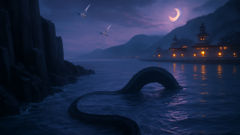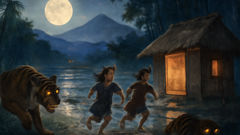Introduction
Amid the labyrinthine waterways and emerald forests of the Chiloé Archipelago, where the sky is often painted with a restless mist and the wind whispers old secrets, the people have always turned to the sea. The Pacific’s cold blue arms cradle these islands, blessing and testing their inhabitants in equal measure. For centuries, the lives of Chilote fishermen and their families have been shaped by the tides, the unseen currents, and the rhythm of abundance and scarcity. Yet beneath these natural cycles, woven into every lullaby and fireside story, lies the legend of the Pincoya—the radiant guardian of the sea’s bounty, whose dance is said to dictate whether the ocean yields its treasures or guards them in silence. In the hearts of the islanders, she is more than myth; she is hope in times of hunger, awe in moments of plenty, and a living reminder that the boundary between the natural and supernatural is as thin as the sea’s veil of morning fog. This is the story of how one community came to know her magic firsthand, and how a young fisherman’s courage and humility would forever change the balance between people and the enchanted sea.
Tides of Uncertainty: Tomás and the Vanishing Harvest
In the village of Caleta de los Vientos, nestled on a narrow finger of land battered by salt and wind, life pulsed with the ocean’s moods. Here, every day began with the briny scent of kelp and the low groan of boats being hauled to the tide. At the heart of the village lived Tomás, a young fisherman with hands rough as driftwood and eyes that mirrored the endless blue. Tomás learned the art of fishing from his father and grandfather, their stories echoing with warnings and wonder about the creatures beneath the waves. But in recent months, those stories had become less about bounty and more about struggle. Nets returned light, and the fish seemed to vanish without reason. The old ones muttered about omens, and mothers worried over thinning soup pots. Even Tomás, steadfast and resourceful, felt the weight of uncertainty settling in his chest.

One morning before dawn, as a veil of cold fog crept across the bay, Tomás joined his friends in pushing their boat into the water. The village’s hopes rested on their catch, but his mind was clouded by unease. As they rowed out, an eerie silence hung over the sea, broken only by the clatter of oars and the distant cry of gulls. The water shimmered with a silvery unease, and Tomás wondered aloud if the Pincoya had turned her back on them. His friend Mateo shrugged, spitting over the side for luck, but the others grew silent. The legend was more than a story here; it was a truth woven into each tide.
The day dragged on beneath a stubbornly gray sky. Again and again, their nets surfaced almost empty—just a handful of wriggling sardines and a solitary, gleaming corvina. The men traded worried glances. That evening, when the boats returned, the entire village gathered on the shingle to witness their meager haul. Children’s faces drooped, and grandmothers shook their heads. Tomás’s mother, Isidora, wrapped her arms around him, offering silent comfort. That night, as Tomás lay in his hammock beneath the flickering shadows of his family’s hut, he listened to the sea’s restless sigh and decided he could not accept defeat. He recalled his grandfather’s words: “If the Pincoya dances facing the sea, the fish will come. But if she turns away, our nets will starve.”
Before dawn, Tomás slipped out with a resolve hardened by necessity. He packed only his grandfather’s old net, a loaf of bread, and a sliver of smoked congrio. He walked the shore until he reached a forgotten cove shrouded by ancient cypresses, where only the bravest dared to fish. Here, according to legend, the veil between worlds was thinnest. The air was thick with anticipation as Tomás set his net and waited. Hours drifted by, punctuated only by the lapping tide and the distant call of a black-faced ibis. As dusk painted the sky with streaks of amber, a sudden current brushed against his feet—a chill that made his heart race.
It was then that he saw her. Rising from the waves was a woman of impossible beauty, her hair dark as kelp and flecked with tiny shells, her skin aglow with moonlight’s touch. Seaweed adorned her as a regal gown, and as she moved, water seemed to dance in her wake. Tomás froze, breathless, as the Pincoya gazed upon him with eyes as deep and endless as the sea. Time slipped away. She began to dance, graceful and slow—each step stirring the water, every twirl leaving trails of light. Yet Tomás’s heart sank as he realized: she faced away from the land, her arms beckoning toward the vast ocean. The old tales were true—her dance decided their fate.
The spell broke with the rising moon. The Pincoya faded back into the waves, leaving Tomás awestruck and humbled. He pulled in his net—empty once again. Alone in the gathering dark, he whispered a prayer to the sea and set off for home, the image of her shimmering silhouette burned forever in his memory.
A Pact with the Sea: The Pincoya’s Test
In the days that followed, Tomás’s secret encounter weighed on him. His dreams filled with swirling water and fleeting glimpses of the Pincoya’s silver eyes. The village’s hunger deepened; tempers frayed over meager meals. Tomás confided in his mother, who listened gravely and pressed a tiny carved amulet—a fish made from native luma wood—into his palm. “The sea is not ours to command,” she whispered, “but we can offer respect. Go again, but not as a taker. Go as a guardian.”

Determined, Tomás set out at twilight, bearing not only his net but gifts for the sea: woven garlands of kelp, a handful of bright shell beads, and a song his grandmother used to sing when storms threatened. This time, he did not cast his net. Instead, he waded into the cool surf, singing softly and letting the offerings drift into the gentle current. The sky bruised to indigo, and stars began to prick the horizon. From the darkness, a voice—soft as the tide—rose in harmony with his own.
The Pincoya appeared again, more radiant than before. Her expression was solemn, yet not unkind. She circled Tomás, her dance slower, as if testing the sincerity of his heart. Waves pulsed with her every movement, and schools of silver fish flickered beneath the surface. Tomás bowed his head. “We honor you, spirit of the water. We ask for your blessing, not just for ourselves but for the sea and all its kin.”
The Pincoya paused, her eyes searching his. “Long have I watched your people,” she replied, her voice echoing like distant surf. “You take and take, forgetting gratitude and balance. If you wish for abundance, prove your respect.”
With that, the spirit beckoned Tomás deeper. Without fear, he followed. The world shifted—colors deepened, sounds became muffled. He found himself standing at the edge of an underwater realm, where forests of kelp swayed like dancers and luminous creatures darted between rocks. Here, the Pincoya showed him wonders: a hidden nursery of fish, ancient shipwrecks blanketed in coral, and the delicate web that connected every living thing in the sea. Tomás saw how careless nets could scar this world, how greed could silence songs that had lasted centuries.
When they returned to the surface, breathless and changed, the Pincoya faced him at last. “Will you promise to teach your people what you have seen? Will you guard the balance between need and respect?” Tomás nodded, tears mingling with seawater on his cheeks. With a final, dazzling spin, the Pincoya danced—this time facing the land. Light exploded across the waves. Fish leaped in silver arcs, and birds wheeled overhead in jubilation. The spirit’s laughter rang out, as wild and free as the ocean breeze.
Tomás returned to the village with nets so heavy they nearly broke. The community rejoiced, feasting and singing beneath a blanket of stars. Yet Tomás knew the real gift was not just abundance, but understanding—the fragile covenant between people and the vast, mysterious sea.
A Dance Remembered: The Spirit’s Legacy
With each new dawn, Caleta de los Vientos flourished. Nets brimmed with fish; mussels gleamed on every rock. Yet Tomás never forgot his vow. He gathered the villagers—old and young—by the fire, sharing tales not just of bounty but of responsibility. He taught them to honor the sea’s cycles: to leave spawning grounds undisturbed, to return the smallest catch, to repair and share nets instead of hoarding. Skeptics grumbled at first, but when storms came and the sea remained generous, their doubts faded.

One autumn night, as rain drummed on thatched roofs, an elder named Juana approached Tomás. Her eyes glinted with wisdom. “My father saw the Pincoya once,” she confided. “He said her dance reflects our hearts. When we are greedy or careless, she turns away. When we honor her, she blesses us.” Tomás nodded, feeling the truth settle in his bones.
Years passed. Children who once went hungry now told their own tales of the Pincoya. Festivals blossomed—each season marked by rituals of thanks: songs offered to the waves, lanterns floated on the tide, and garlands of seaweed left along the shoreline. The spirit’s presence became a living part of village life—a whisper in the surf, a shimmer on moonlit nights, a sudden rush of fish after days of patience.
Tomás grew older, his hair silvering like the scales of a corvina. He never sought to command the Pincoya again but watched for her with quiet reverence. On rare nights, he glimpsed her dancing on distant waves—always facing the land, her luminous figure a promise that nature’s gifts are never owed, only earned through care and humility.
In time, Caleta de los Vientos became renowned across Chiloé for its respect of the sea. Fishermen from distant coves came to learn the village’s ways. Tomás welcomed them, repeating what had become his creed: “The Pincoya does not belong to us. We belong to the sea.” And so her legend lived on—not as a relic of fear or superstition, but as a guiding light for generations. The boundary between myth and reality blurred on these misty shores, where every ripple might hide a blessing and every sunrise was greeted with gratitude.
Conclusion
In the Chiloé Archipelago, where land and sea are forever entwined, the legend of the Pincoya endures. Her story is not only about magic and mystery but about harmony—between people and nature, desire and restraint, giving and receiving. The people of Caleta de los Vientos learned that the greatest abundance comes not from taking without thought, but from respecting the delicate dance that sustains all life. Their faith in the Pincoya transformed their fortunes and wove a new story into the very fabric of their community—a story in which every net cast is balanced by gratitude, every harvest by humility, and every sunrise by hope. Even now, when fishermen spot a sudden shimmer on the waves or hear laughter in the spray, they pause to remember: the Pincoya still watches, her dance shaping the fate of all who call the sea their home.













